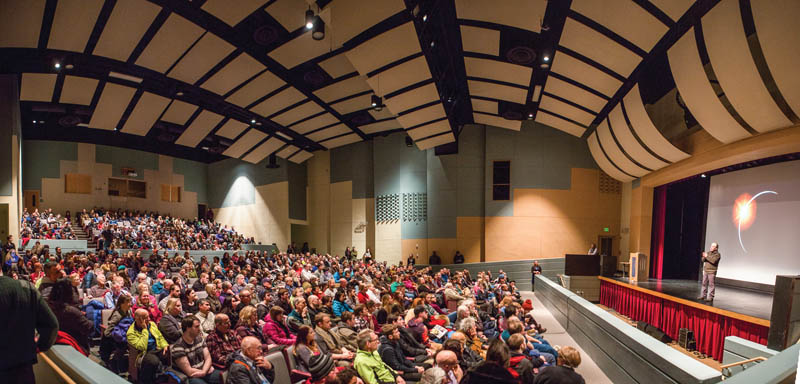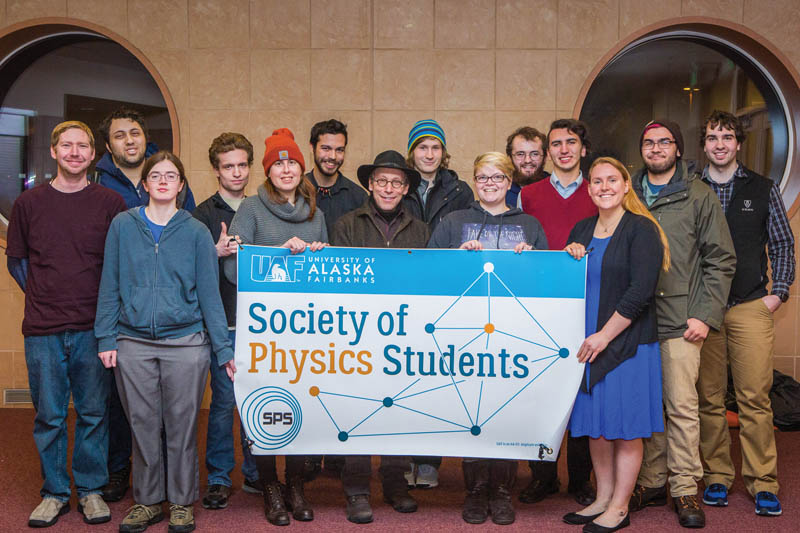Hidden Realities: Lawrence Krauss’s Trip to Alaska
Fall
2017
Meeting Notes - SPS Reporters at Science Conferences
Hidden Realities: Lawrence Krauss’s Trip to Alaska
Georgeanna Heaverley, SPS Member, University of Alaska Fairbanks

Once I chose to return to school to study physics, joining the Society of Physics Students has been the highlight of my career at the University of Alaska Fairbanks (UAF). We are a small chapter, but we have done everything from judging local science fairs to organizing large fundraisers, hosting stargazing parties, and even sending 12 students to the 2016 Quadrennial Physics Congress in San Francisco. But our most ambitious goal was to bring a renowned physicist to UAF to hold a public lecture, and we wanted to think big.
A past generation of SPS members had brought Nobel laureate Richard Feynman to UAF. We set our sights just as high as our predecessors had. On a tepid evening last May, in the company of the increasingly persistent midnight sun, I sat down with two other SPS members and composed an email to Dr. Lawrence Krauss, a renowned theoretical physicist, author, and educator.
I first saw Lawrence Krauss on the Science Channel five years ago, on the program How the Universe Works. I could see his affinity for the public understanding of science, and he quickly became my favorite physicist. His documentary with Richard Dawkins and his bestselling book, “A Universe from Nothing,” were the inspiration behind my decision to go back to school as an older student and get a degree in physics.
We invited Krauss to visit Fairbanks and share his expertise, noting that it would greatly inspire us as future physicists, and making sure to mention Professor Feynman’s past trip. I was not sure we would even receive a response.
Within one hour of sending the invitation, Krauss personally responded. “It is hard to turn down an invitation like this, especially to follow in Feynman’s footsteps,” he wrote. “Let’s try and make this happen.” We were ecstatic.
After long negotiations, we arrived at a deal and a date was set. It was 20º below when Dr. Krauss landed in Fairbanks, typical for early March. Our Society’s vice president, Riley, and I met him at the airport. We set off on the short ride to the hotel, and as we drove away from the lights of the airport Dr. Krauss received the greatest welcome that Alaska could give him—a front row seat to the aurora borealis. He could not contain his awe as the vivid green ribbons danced across the sky. Even Riley and myself, both lifelong Alaskans, agreed they were some of the best lights we had ever seen. We left Dr. Krauss to marvel at one of the crown jewels of Alaska, and made plans to pick him up in the morning.
Dr. Krauss’s public lecture was titled, “Hidden Realities: The Greatest Story Ever Told… So Far,” and it was about his upcoming book of the same title. Over 500 people turned out to hear the lecture. The auditorium was standing room only!
Dr. Krauss was electric as he discussed the progression of humankind’s understanding of the universe and the great minds that got us there. From Plato to Faraday, from Maxwell to Einstein and Feynman—he explained our grasp of the physical phenomena that surrounds us.
He explained the importance of the Higgs boson in a way everyone could actually understand. He stressed the importance of scientific discovery and how it contributes to our picture of reality. One point that truly resonated with me was a quote from experimental physicist Robert R. Wilson, the first director of Fermilab. Dr. Krauss told us that when asked by Congress if the new particle accelerator would contribute to our national security, Wilson responded, “It has nothing to do directly with defending our country, except to make it worth defending.” These words remind me how important it is to remember this very thing: scientific inquiry and discovery make our lives worth something.
After the lecture, Dr. Krauss signed autographs, posed for photos, and answered questions for nearly an hour. After leaving the auditorium, he said the size of the crowd was truly humbling; he did not expect that kind of showing.
The following day was packed with uniquely Alaskan activities. We toured the Cold Regions Research Engineering Laboratory permafrost tunnel, spotting remnants of Pleistocene animals and huge chunks of ice, all tens of thousands of years old. We viewed sculptures at the World Ice Art Championships, and even sent Dr. Krauss on a short dogsled ride.
As I said goodbye to Lawrence Krauss that night, I thanked him for giving such an incredible lecture, and for coming to our frozen town with such a positive attitude, willing to take on the adventure of Alaska.
To all the little SPS organizations out there: Set your sights high. We never could have dreamed we would be hosting such a renowned scientist in our little town in Alaska. These things don’t happen every day. It was certainly hard work to organize this trip, but what we accomplished is proof that you, too, can do it. All you have to do is ask.

To read the full version of this article, check-out
www.spsnational.org/meetings/meeting-notes/hidden-realities-lawrence-krauss’s-trip-alaska
